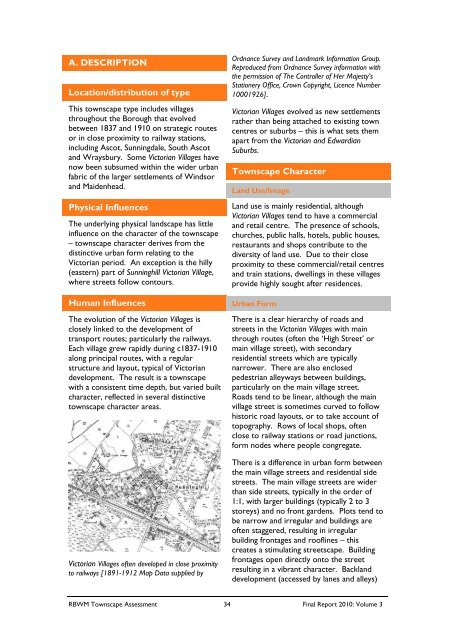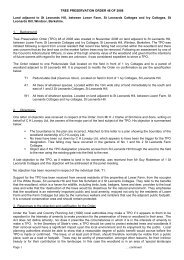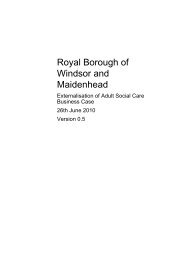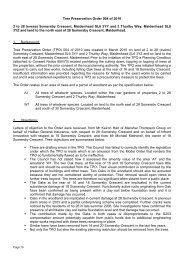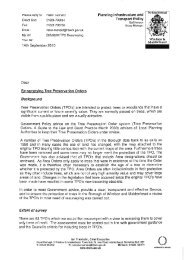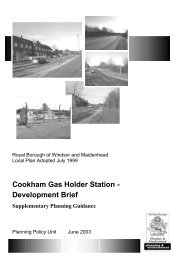5: victorian villages - The Royal Borough of Windsor and Maidenhead
5: victorian villages - The Royal Borough of Windsor and Maidenhead
5: victorian villages - The Royal Borough of Windsor and Maidenhead
Create successful ePaper yourself
Turn your PDF publications into a flip-book with our unique Google optimized e-Paper software.
A. DESCRIPTION<br />
Location/distribution <strong>of</strong> type<br />
This townscape type includes <strong>villages</strong><br />
throughout the <strong>Borough</strong> that evolved<br />
between 1837 <strong>and</strong> 1910 on strategic routes<br />
or in close proximity to railway stations,<br />
including Ascot, Sunningdale, South Ascot<br />
<strong>and</strong> Wraysbury. Some Victorian Villages have<br />
now been subsumed within the wider urban<br />
fabric <strong>of</strong> the larger settlements <strong>of</strong> <strong>Windsor</strong><br />
<strong>and</strong> <strong>Maidenhead</strong>.<br />
Physical Influences<br />
<strong>The</strong> underlying physical l<strong>and</strong>scape has little<br />
influence on the character <strong>of</strong> the townscape<br />
– townscape character derives from the<br />
distinctive urban form relating to the<br />
Victorian period. An exception is the hilly<br />
(eastern) part <strong>of</strong> Sunninghill Victorian Village,<br />
where streets follow contours.<br />
Human Influences<br />
<strong>The</strong> evolution <strong>of</strong> the Victorian Villages is<br />
closely linked to the development <strong>of</strong><br />
transport routes; particularly the railways.<br />
Each village grew rapidly during c1837-1910<br />
along principal routes, with a regular<br />
structure <strong>and</strong> layout, typical <strong>of</strong> Victorian<br />
development. <strong>The</strong> result is a townscape<br />
with a consistent time depth, but varied built<br />
character, reflected in several distinctive<br />
townscape character areas.<br />
Victorian Villages <strong>of</strong>ten developed in close proximity<br />
to railways [1891-1912 Map Data supplied by<br />
Ordnance Survey <strong>and</strong> L<strong>and</strong>mark Information Group.<br />
Reproduced from Ordnance Survey information with<br />
the permission <strong>of</strong> <strong>The</strong> Controller <strong>of</strong> Her Majesty’s<br />
Stationery Office, Crown Copyright, Licence Number<br />
10001926].<br />
Victorian Villages evolved as new settlements<br />
rather than being attached to existing town<br />
centres or suburbs – this is what sets them<br />
apart from the Victorian <strong>and</strong> Edwardian<br />
Suburbs.<br />
Townscape Character<br />
L<strong>and</strong> Use/Image<br />
L<strong>and</strong> use is mainly residential, although<br />
Victorian Villages tend to have a commercial<br />
<strong>and</strong> retail centre. <strong>The</strong> presence <strong>of</strong> schools,<br />
churches, public halls, hotels, public houses,<br />
restaurants <strong>and</strong> shops contribute to the<br />
diversity <strong>of</strong> l<strong>and</strong> use. Due to their close<br />
proximity to these commercial/retail centres<br />
<strong>and</strong> train stations, dwellings in these <strong>villages</strong><br />
provide highly sought after residences.<br />
Urban Form<br />
<strong>The</strong>re is a clear hierarchy <strong>of</strong> roads <strong>and</strong><br />
streets in the Victorian Villages with main<br />
through routes (<strong>of</strong>ten the ‘High Street’ or<br />
main village street), with secondary<br />
residential streets which are typically<br />
narrower. <strong>The</strong>re are also enclosed<br />
pedestrian alleyways between buildings,<br />
particularly on the main village street.<br />
Roads tend to be linear, although the main<br />
village street is sometimes curved to follow<br />
historic road layouts, or to take account <strong>of</strong><br />
topography. Rows <strong>of</strong> local shops, <strong>of</strong>ten<br />
close to railway stations or road junctions,<br />
form nodes where people congregate.<br />
<strong>The</strong>re is a difference in urban form between<br />
the main village streets <strong>and</strong> residential side<br />
streets. <strong>The</strong> main village streets are wider<br />
than side streets, typically in the order <strong>of</strong><br />
1:1, with larger buildings (typically 2 to 3<br />
storeys) <strong>and</strong> no front gardens. Plots tend to<br />
be narrow <strong>and</strong> irregular <strong>and</strong> buildings are<br />
<strong>of</strong>ten staggered, resulting in irregular<br />
building frontages <strong>and</strong> ro<strong>of</strong>lines – this<br />
creates a stimulating streetscape. Building<br />
frontages open directly onto the street<br />
resulting in a vibrant character. Backl<strong>and</strong><br />
development (accessed by lanes <strong>and</strong> alleys)<br />
RBWM Townscape Assessment 34 Final Report 2010: Volume 3


